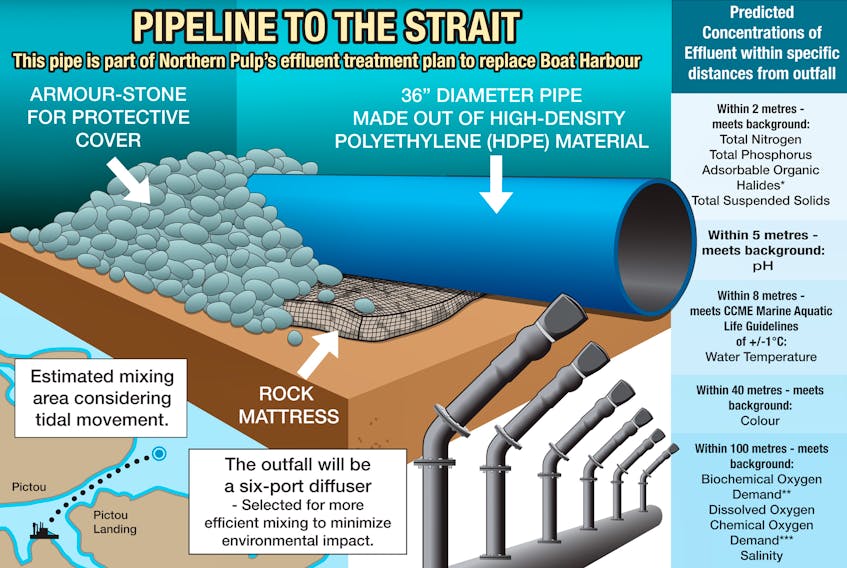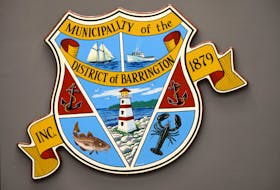NEW GLASGOW
New Glasgow town councillors had a heated discussion over the future of Northern Pulp’s proposed effluent treatment process, the legacy of Boat Harbour and the future of the Northumberland Strait.
Coun. Frank Proudfoot raised a matter discussed earlier, at the June 18 meeting, when council decided to accept a presentation from members of the Friends of the Northumberland Strait as received information.
Proudfoot made a motion for council to support requesting a Class 2 assessment of Northern Pulp’s proposed treatment method to replace Boat Harbour, set to close in 2020.
CAO Lisa MacDonald clarified that assessments are submitted to the province, which then sends the application for one to the federal government. Provincially, Nova Scotia Environment, Nova Scotia Natural Resources, Aboriginal Affairs and Community Culture and Heritage are involved. Federally, the Department of Fisheries and Oceans, the Department of Environment and Climate Change, Health Canada, Transport Canada and the Canadian Environmental Assessment Agency are involved in the review of an application for an assessment.
“It’s our area, and the bottom line ... is that it’s not about whether there should be a pipe or no pipe. Is it worth a six-month delay to ensure we have all the information necessary to make a proper informed decision?” asked Proudfoot.
“The only reason not to want a full study is because you fear the outcome of the study. Why else would you not ask for a full study? The alternative – going ahead without realizing the potential disastrous effects – is unforgivable.”
Proudfoot was critical of past decisions the province made regarding mill effluent, asking, “How could they have allowed Boat Harbour to happen?”
MacDonald clarified, stating that a Class 1 assessment is related to an already-existing company, while a Class 2 assessment is for a new company that has hasn’t begun operating, adding that the classification has nothing to do with the depth or thoroughness of the study.
MacDonald said that if any of the federal agencies consulted in the assessment have a problem with the information given to them, they will notify the province, and raise a red flag for the project.
Proudfoot said a Class 1 assessment is inadequate, prompting Coun. Troy McCulloch to insist that council “respect the process. Let the science tell us what to do. If it’s going to stop or harm the fishers, one of these scientists will tell us at some point.”
Proudfoot indicated that he believes the water quality in the Northumberland Strait is in jeopardy, referring to high cancer rates in Pictou County compared to the rest of Canada. He said they need to take every possible step to guarantee there will be no environmental damage from effluent.
While McCulloch said council should trust the assessment, Proudfoot replied, “the system has let us down for 50 years.
“I think we want to hear more,” said Coun. Jack Lewis, calling for a special meeting. “I want to hear from the Department of Environment… about the proper procedure.”
Lewis said it’s not “just mills and fisheries,” and that the question of effluent disposal into the Strait affects an assortment of spinoff industries, such as lumber.
“There are people on all sides, and all I’m hearing is that the mill wants to put a pipe out there, and that the fishermen don’t want a pipe. There is a ton of people that aren’t speaking up,” added Lewis.
Ultimately, council passed a motion to consult the Department of Environment to find out specifically what the assessment process entails, so that council can make the most informed decision as possible.
What’s the difference?
Class 1 undertakings are usually smaller in scale and may or may not cause significant environmental impacts or be of sufficient concern to the public. Therefore, a public review of a proponent's initial submission or registration is required and the Minister will decide if a more detailed review and/or public hearing is required. These types of developments include, but are not limited to, mines, certain highways and waste dangerous goods handling facilities.
Class 2 undertakings are typically larger in scale and are considered to have the potential to cause significant environmental impacts and concern to the public. These types of developments include, but are not limited to, solid waste incinerators, petrochemical facilities and pulp plants. These undertakings require an environmental assessment report and formal public review which may include hearings.
Source: Nova Scotia Environment









